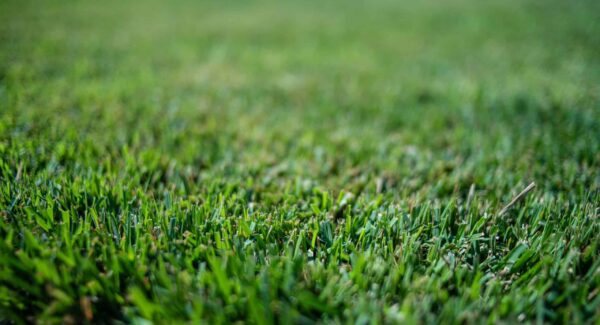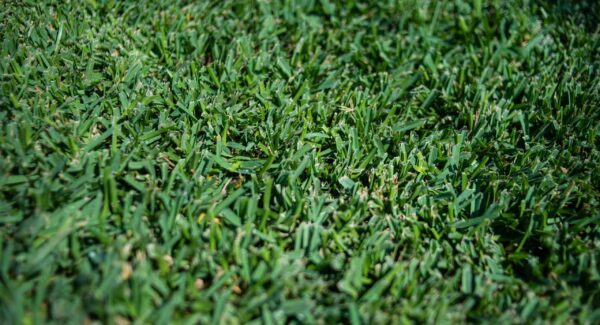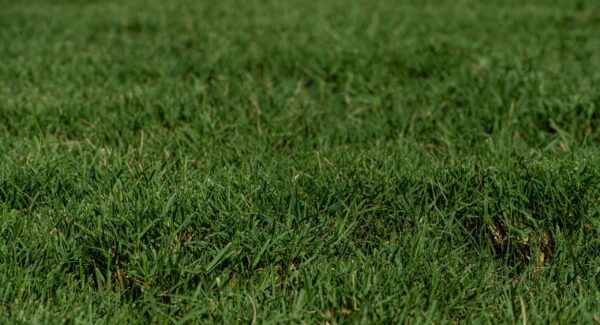How Late is Too Late to Lay Sod?
Everyone embarking on the project of installing sod may wonder: “When is the best time to lay sod?” This question frequently arises in everyday situations – for instance, when moving into a new home and wanting to establish a healthy lawn or when trying to revive a lawn after a prolonged drought.
Homeowners often ask whether the timing they’ve planned is suitable for laying sod or how late is too late to lay sod. Can sod root appropriately during colder months? Is it safe to install it amid summer heat? What if rainfall isn’t consistent? These are valid concerns because choosing the wrong time of year can lead to poor rooting and unnecessary disappointment.
The truth is sod can be laid almost year-round, but there are specific periods when conditions are optimal for healthy growth. Timing is critical in the entire process – from rooting to long-term resilience.
In this text, we’ll address these typical uncertainties, explore the best times for laying sod, and explain key factors to consider. Whether planning a fall installation or preparing for spring planting, this guide will help you make an informed decision and pave the way to the lush, green lawn you’ve always dreamed of.
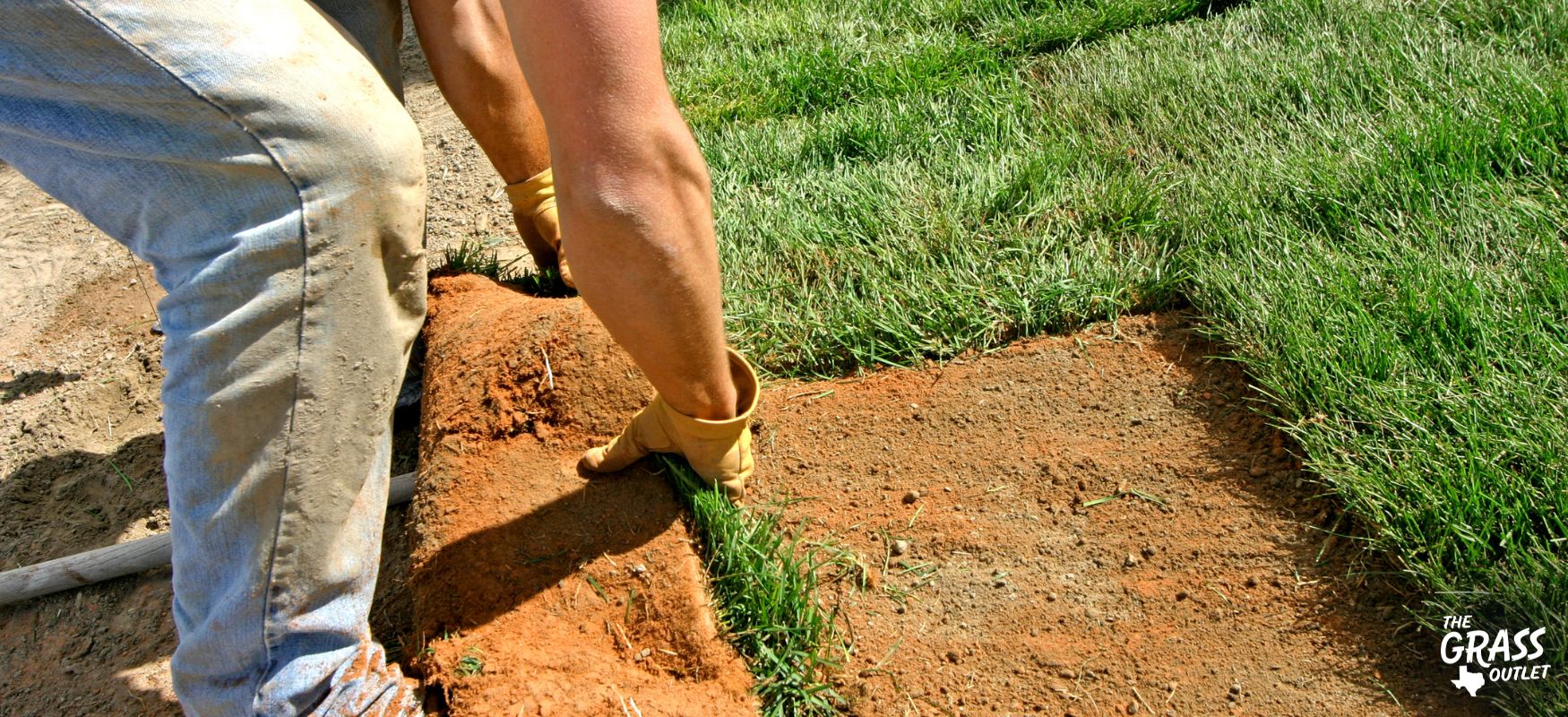
Understanding the Best Time to Lay Sod
Spring and early fall are considered the optimal periods for laying sod due to weather conditions that support healthy rooting and favorable soil conditions. During these seasons, temperatures are moderate – neither too hot nor too cold – creating ideal conditions for sod growth and development.
Why Fall Is a Good Time to Lay Sod
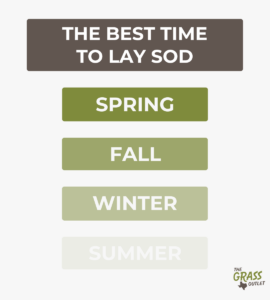
Autumn rains help maintain consistent soil moisture, which is crucial for the sod to develop strong roots. Additionally, as the weather becomes cooler, lawns experience less foot traffic, allowing the sod to root and grow undisturbed. This gives the lawn ample time to strengthen and prepare for winter, ensuring it emerges thick and healthy in the spring.
Spring Sod Installation – The Perfect Timing
Spring is also an excellent time to lay sod because temperatures are warm enough to encourage growth but not too high to hinder rooting. Spring rains are a valuable ally, maintaining the necessary moisture levels during the critical rooting period.
Installing sod in spring ensures your lawn will be ready for summer activities, whether hosting outdoor gatherings or for everyday use. Furthermore, a fresh layer of sod in spring can help suppress weeds, giving your lawn a healthier start for the growing season.
Why Timing Is Crucial for Sod Installation
Laying sod in the middle of summer or late winter can present significant challenges. During the summer, high temperatures can quickly dry out the sod, making it difficult for it to take root. On the other hand, winter installation poses issues as frozen soil prevents the sod from establishing a proper connection with the ground.
By choosing spring or early fall, you take advantage of optimal conditions, ensuring excellent results in the growth and flourishing of your lawn.
Factors That Determine How Late You Can Install Sod
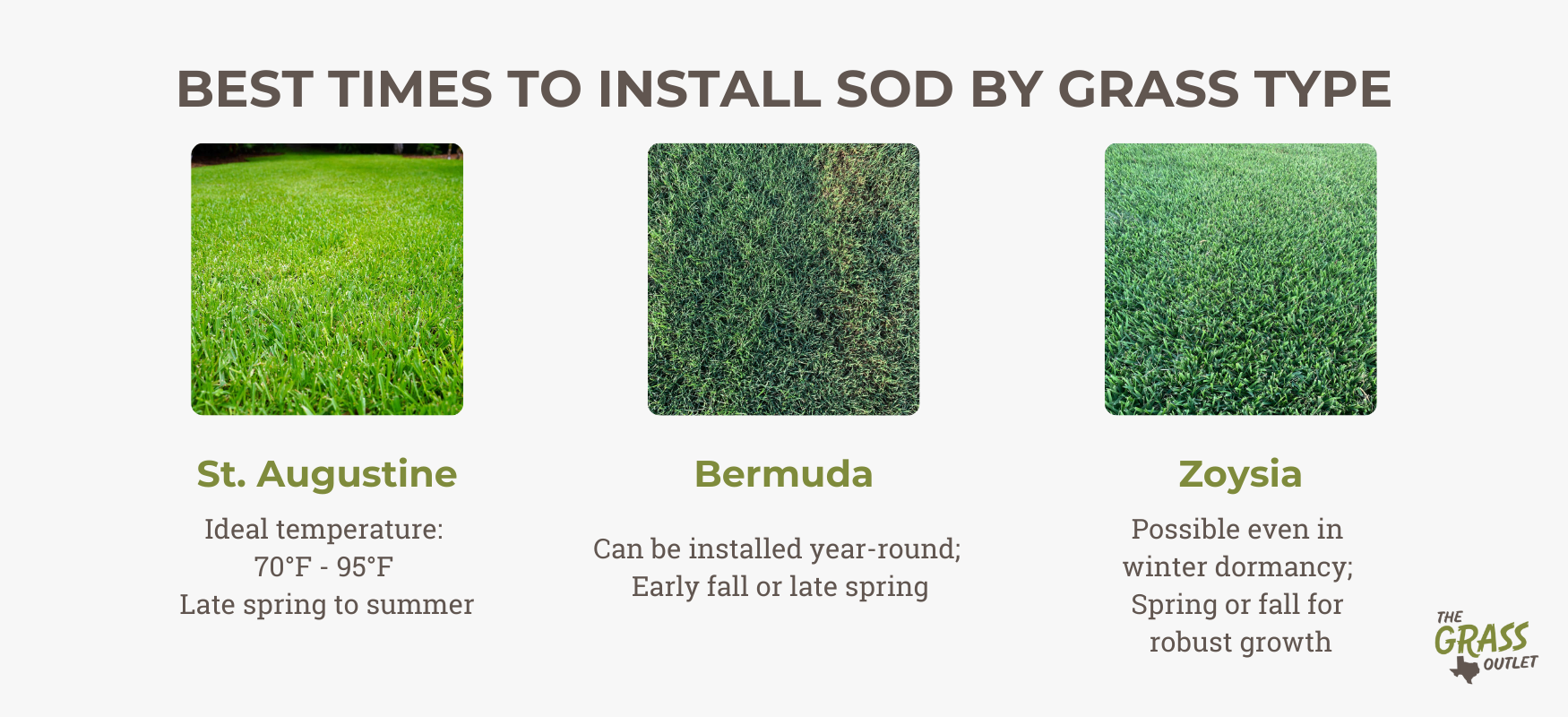
Climate and local weather conditions are critical in how well new grass roots develop. Understanding the specific climate patterns in your region—ranging from temperatures and rainfall to seasonal extremes—can make a significant difference between a lush, healthy lawn and one struggling to survive. This highlights the importance of monitoring local weather and climate trends closely.
The differences between the northern and southern regions of Texas present unique challenges. While the southern parts of Texas benefit from summer heat waves that create ideal conditions for warm-season grasses like Bermuda grass, Zoysia, and St. Augustine grass, northern regions require more careful planning to avoid early frosts.
The best time to install sod for Bermuda, Zoysia, or St. Augustine grass is from late spring to summer when temperatures range between 70°F and 95°F. These conditions promote rapid root development and optimal lawn growth.
However, in northern Texas, where winters can be harsher, it’s crucial to complete sod installation before the first frosts. For Texas north, October is ideal, offering moderate temperatures and plenty of time before frost sets in.
- Augustine: The best time to lay St. Augustine sod is when temperatures are between 70°F and 95F. In Texas, this typically spans late spring through the end of summer.
- Bermuda: While Bermuda sod can be installed almost year-round, the optimal time is early fall or late spring.
- Zoysia: Zoysia sod can be installed even in winter when the grass is dormant, but spring or fall remains the best time for planting to achieve ideal growth conditions.
Weather Conditions to Consider When Installing Sod
Avoid laying sod during drought conditions. Newly installed grass requires consistent watering, and a lack of rainfall combined with high temperatures and water restrictions can cause it to dry out before it establishes roots.
Heavy rains can also pose challenges, as muddy conditions make it difficult to level the soil and properly lay the sod, leading to uneven growth.
The ideal timing to lay sod usually involves a balance of sunny days and moderate rainfall, as these conditions provide sufficient moisture without oversaturating the soil.
What Are the Risks of Late Sod Installation?
If circumstances lead you to install sod late in the season, especially right before winter, it comes with particular challenges and risks.
Insufficient Root Development Before Winter Dormancy
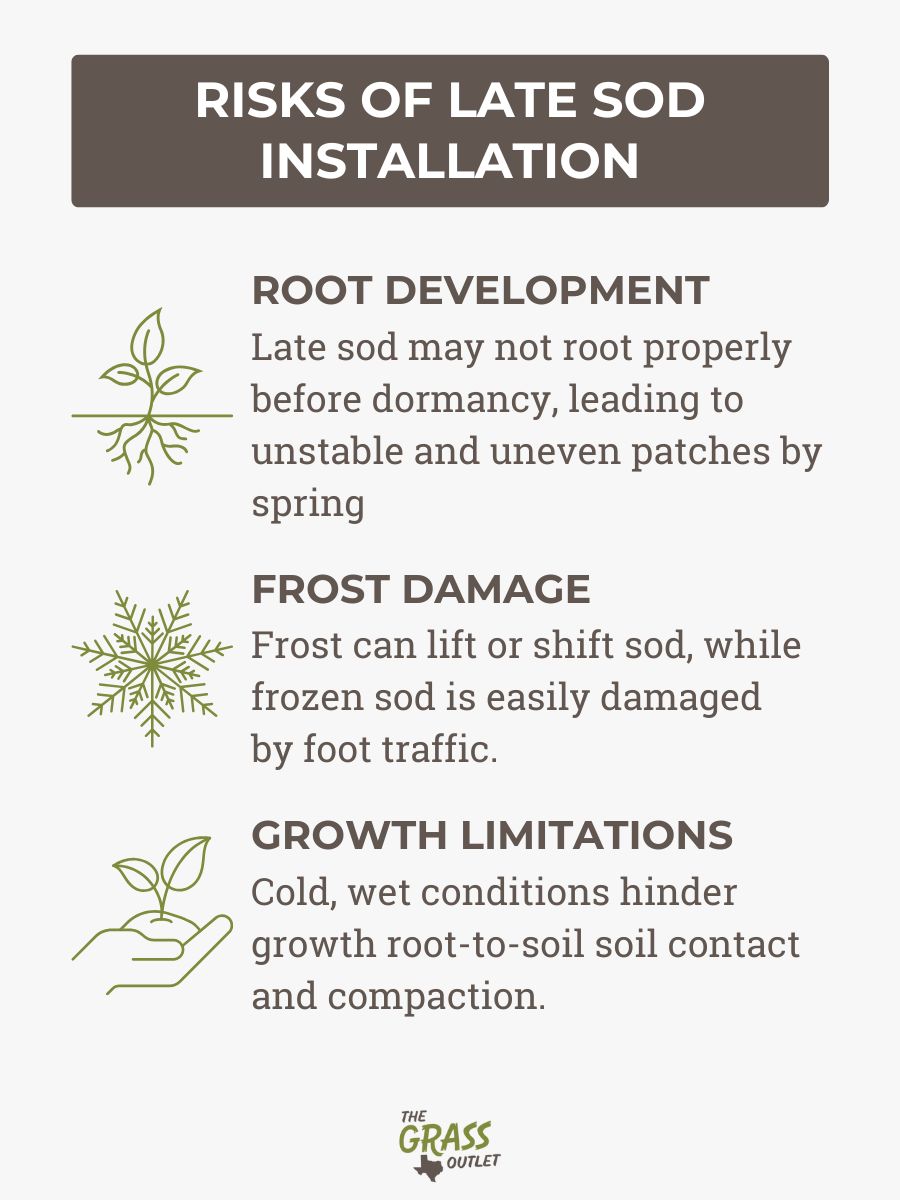
- Expert Tip: Proper preparation, such as soil aeration and regular watering your lawn, can mitigate this risk, but these efforts are less effective once temperatures drop rapidly.
Increased Risk of Frost and Cold Damage
While sod, particularly cool-season varieties, is designed to withstand low temperatures, freshly installed sod is more susceptible to frost damage and freezing. Frost can cause the sod to lift or shift, disrupting contact with the soil. Walking on frozen sod can further damage or destroy the delicate grass blades.
- Practical Advice: If sod must be installed late in the season, avoid walking on it or placing heavy objects on it during frosty conditions. This reduces the risk of mechanical damage over winter.
Reduced Quality and Growth Potential of Sod
Installing sod in late fall or early winter may limit its initial growth potential. Grass that fails to root before dormancy can struggle to thrive come spring. Additionally, sod laid in cold, wet conditions may suffer from soil compaction, poor drainage, and insufficient root-to-soil contact, all of which negatively impact the long-term health of the grass.
- Real-World Example: Although resilient sod can survive extreme conditions, such as freezing after a rare winter snowstorm, these outcomes are exceptions rather than the norm. Without proper timing, the risk of weak or delayed recovery in spring significantly increases.
Can Sod Be Installed Late in the Season?
Installing sod late in the season, even just before winter, is not only possible but, under certain circumstances, can also be recommended – Especially in Central Texas, where warm winters are quite common. For the process to be successful, it’s essential to understand the weather conditions and grass types and perform proper soil preparation.
This practice often raises skepticism due to lower temperatures and potential frosts, but with the right approach, the late season can be a suitable time for sod installation, particularly in areas that commonly have water restrictions during warmer months.
When Is It Possible to Lay Sod in that period?
In regions with mild winters and extended warm autumn days, such as the southern United States or Mediterranean areas, laying sod in late fall or early winter can be very successful. Soil temperature is crucial—as long as the ground is warm enough to support minimal root system activity, the grass can begin to root.
Ideal soil conditions are essential. The soil should be well-leveled, loose, and rich in nutrients. Proper drainage is also necessary to prevent water retention, which could lead to root rot during colder months.
During winter, most warm-season grasses enter a dormant phase. This means the plant slows its growth, reducing the need for water and fertilizer. Although root growth is not as intense as in warmer months, it still occurs, providing an advantage for the spring when temperatures rise.
How to Properly Install Sod?
It is ideal for laying sod when daily temperatures do not drop below 40 to 50°F, and the soil is not frozen. If prolonged frosts are expected, it is better to postpone the installation.
Although water requirements are reduced in winter, the soil must remain moderately moist to allow the roots to start connecting with the ground. Avoid excessive watering.
In areas with occasional cold waves, a thin layer of mulch can protect the grass roots from frost and freezing temperatures, and improve heat retention.
What Are the Advantages of Installing Sod Late in the Season?
- Sod installed in late fall or winter won’t be exposed to stress from high temperatures, significantly increasing the chances of successful rooting.
- During dormancy, grass requires minimal watering and fertilization, making it an attractive option for homeowners who want a less demanding start to lawn care.
- Sod laid at the end of the season has enough time to develop essential root connections before the intense growth begins in the spring, putting it in a better position compared to grass installed in early spring.
Tips for Laying Sod Late in the Season
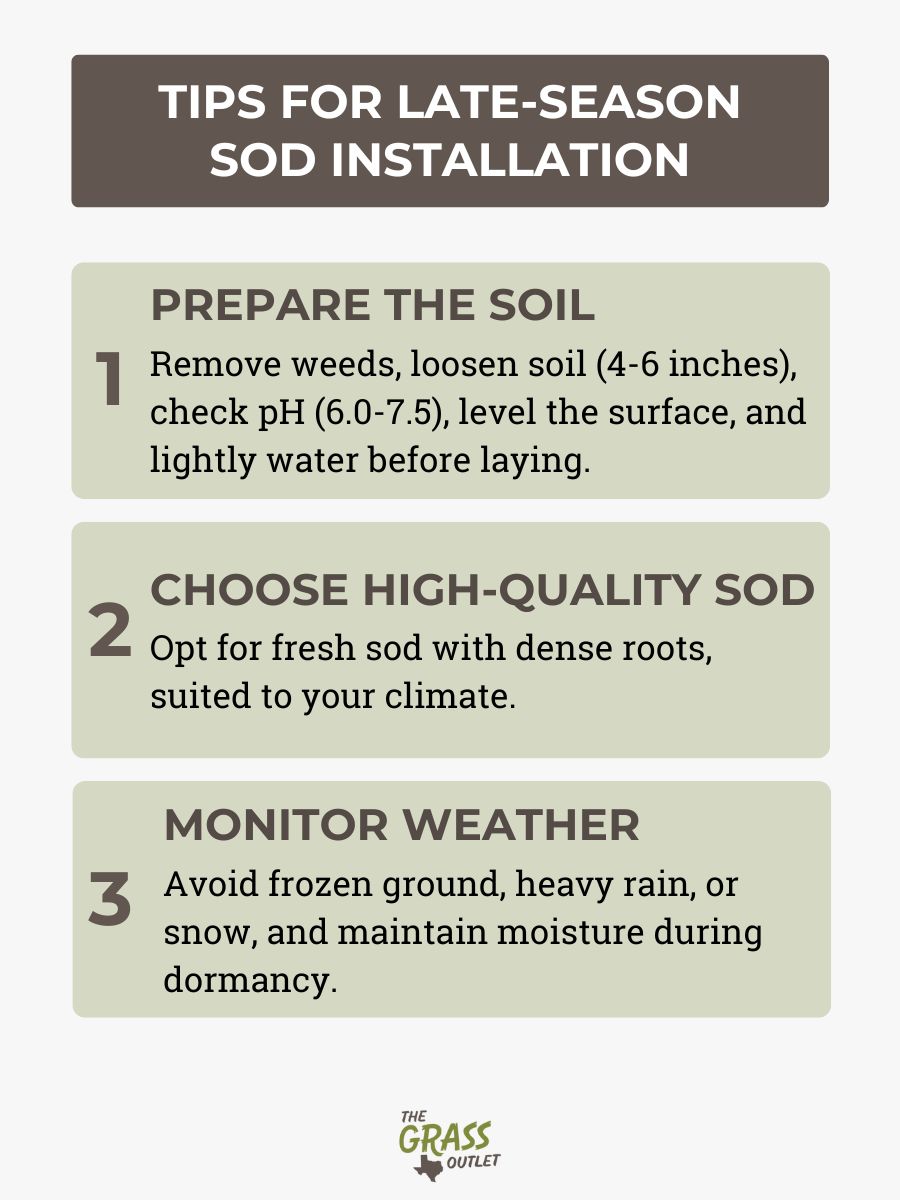
- Remove any leftover grass and weeds to ensure the sod has direct contact with the soil, enabling faster root development.
- Loosen the soil to a depth of 4-6 inches (10–15 cm) to improve drainage and make it easier for the sod to root.
- Test Soil pH and Nutrient Levels. The ideal pH range is between 6.0 and 7.5.
- Level the Soil Surface. Remove any uneven spots to prevent water pooling or frost damage. Before laying the sod, lightly water the soil, but avoid overwatering, as this can lead to freezing.
Focus on Sod Quality
Late fall or early winter provides less time for the sod to root before entering dormancy, making sod quality crucial.
Choose a sod provider that harvests fresh grass and delivers farm direct within 24 hours of harvesting. Check the roots; dense and firm roots are essential for quick rooting in colder conditions. You should also select a grass variety suitable for your climate and season.
Carefully Monitor Weather Conditions
Weather plays a critical role in laying sod late in the season. Plan for a period with stable weather and no forecasted snow. Sod can be installed as long as the ground is not frozen.
- Watch for rain or excess moisture; heavy rains can saturate the soil and hinder root development.
- Take advantage of the dormancy period. If the sod remains dormant during winter, ensure it receives enough moisture to prevent dehydration (about a ¼ inch per week to keep the topsoil moist).
What Are the Alternatives to Late Sod Installation?
If you missed the optimal time to lay sod, don’t worry—there are practical solutions to help prepare your lawn for the next season.
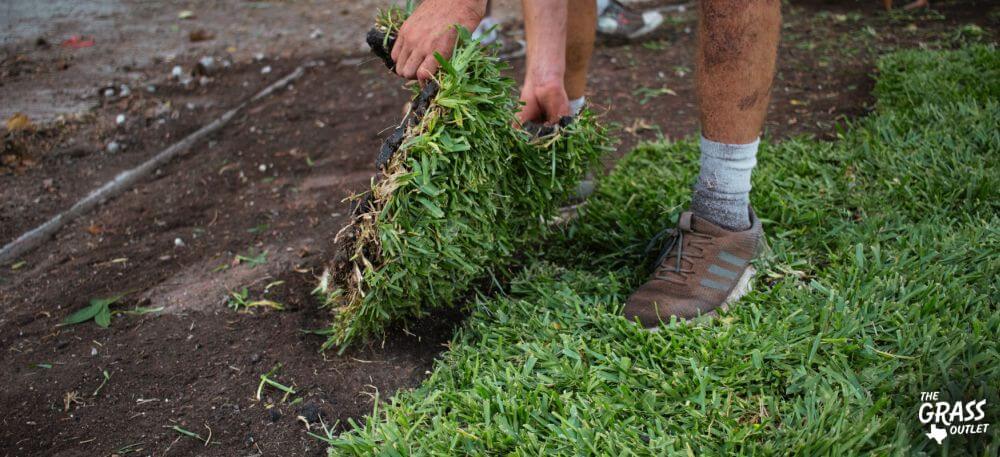
Dormant Seeding
One of the best options is dormant seeding, done during the winter while the lawn is dormant. This involves planting seeds before the growing season begins in January or February, taking advantage of moisture from snow or rain.
What Are the Benefits of Dormant Seeding? It is particularly effective in areas with frequent precipitation or snow and promotes denser and stronger grass growth in the spring.
You can perform dormant seeding using a seed broadcaster (a simpler method) or a slit seeder (more effective, as it cuts into the lawn and helps the seeds root deeper).
Before planting grass seeds, weigh the pros and cons of sodding vs. seeding.
Wait for the Next Growing Season
If you’re unable to sow seeds or lay sod during the winter, it’s best to wait for spring, when planting conditions will be optimal.
Planting grass at the right time increases the chances of healthy and even growth while reducing the need for intensive care.
Conclusion
While early spring and fall are considered the ideal periods for laying sod, primarily due to favorable outdoor temperatures, sod can still be installed later in the season if you don’t have the chance to do so during the recommended time. If you live in regions with mild winters, you’ll find the climatic conditions more accommodating.
That said, it’s important to note that late-season sod installation requires careful monitoring of multiple factors. It’s recommended to understand your region’s weather conditions, the type of grass you’re using, and proper soil preparation. Choose healthy sod with strong roots, as it needs to root well before spring, which requires suitable conditions. Never lay sod when temperatures are below 40°F.
For any questions or uncertainties on this topic, contact The Grass Outlet.
Sources:
- What Is The Best Time of Year to Lay Sod?
- Can You Lay Sod in the Winter?
- When is The Best Time to Lay Sod?
